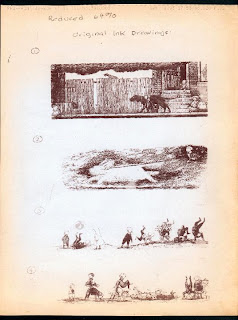 Another 1965 illustration project for Edward Gorey was Alvin Steadfast on Vernacular Island (published by Taplinger Publishing Co. New York, illustrated dust jacket, plain brown cloth binding). The drawings for this book have many unusual creatures in them which lend themselves to Mr. Gorey's talents.
Another 1965 illustration project for Edward Gorey was Alvin Steadfast on Vernacular Island (published by Taplinger Publishing Co. New York, illustrated dust jacket, plain brown cloth binding). The drawings for this book have many unusual creatures in them which lend themselves to Mr. Gorey's talents. In Spring 1985, Bill and I attended the ABAA New York Antiquarian Book Fair, something we try and do most years. On this visit, a booth had two pieces of original artwork by Edward Gorey for sale. At the time, I only had two pieces of Gorey art, so it was a thrill to see the pieces. One was the drawing for page 23 from Alvin Steadfast (shown at the right).
In Spring 1985, Bill and I attended the ABAA New York Antiquarian Book Fair, something we try and do most years. On this visit, a booth had two pieces of original artwork by Edward Gorey for sale. At the time, I only had two pieces of Gorey art, so it was a thrill to see the pieces. One was the drawing for page 23 from Alvin Steadfast (shown at the right).The second piece of Gorey art which was in the booth is the illustration shown at the left. The piece is taller than many Gorey illustrations, being 3.25" wide by 9" tall.
 I was unable to purchase any artwork at the bookfair, but some months later a different dealer contacted me and told me he had run across an original Gorey (he had purchased it from the dealer at the bookfair), and I ended up buying the art from him.
I was unable to purchase any artwork at the bookfair, but some months later a different dealer contacted me and told me he had run across an original Gorey (he had purchased it from the dealer at the bookfair), and I ended up buying the art from him.I still do not know what book or publication this piece was created for. There is a notation in pencil giving a page number at the bottom of the piece, and it is signed by Mr. Gorey. Other than that, there is no indication on the piece as to where it was used. It was suggested that it may have been created for The Harvard Review because it matches the format Gorey often used for the publication, but I have not been able to confirm or deny this. I am hoping that somebody will recognize the piece and end my decades long search!

















